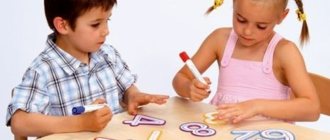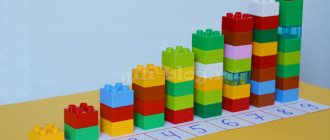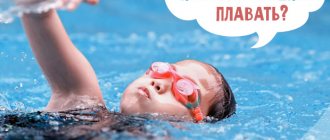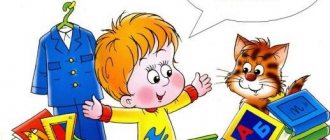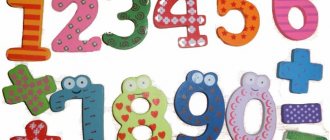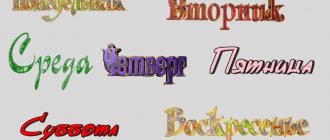Mental arithmetic is a skill that will be useful to a child not only at school, but also in everyday life. If you still doubt whether you should teach children to count in their heads, here are good reasons:
- mental arithmetic develops the ability to think rationally and improves mental abilities (memory, logic, concentration);
- useful in everyday life - calculate a discount in a store, account balance;
- it is part of development, as necessary a skill as the ability to read and write.
In this article we talk about the nuances of training and the most popular methods.
Methods of teaching counting
In children, visual-figurative thinking predominates.
The problem is that most mathematical concepts are abstract and difficult for younger students to grasp or remember. Therefore, any mathematical operations must be based on practical actions with objects. Teachers use three main ways to teach a child to count in his head:
- based on knowledge of the composition of numbers;
- learning tables of mathematical operations by heart;
- using special techniques for performing mathematical operations.
Let's look at each of them.
Where to start
To start teaching your child to count, you don’t need to set aside time and wait for the right opportunity. At the first stages, mathematics (intermediate group) is suitable - counting within 5.
Showing numbers, talking about numbers, the number of objects and why they are needed should be done in a playful way that is easy and accessible to a small child. For example:
- It is worth asking to show the dogs on the street and voice this number, and then count together.
- You can count the molds that were brought into the sandbox.
- It is useful to purchase special cards for kids, which depict animals and a number that indicates their number.
Types of thinking in preschool children
Note! You can come up with simple examples yourself and include them in games and activities. This way, the child will quietly learn the simplest mathematical operations and recognize numbers from one to five, and then beyond.
Cut out numbers
Preparing to teach mental arithmetic
Preparation for mental arithmetic should begin with the first steps in studying mathematics. When introducing a child to numbers, it is imperative to teach him that each number represents a group with a certain number of objects. It is not enough to count, for example, to three and show the child the number 3. Be sure to invite him to show three fingers, put three candies in front of him, or draw three circles. If possible, associate the number with fairy-tale characters or other concepts known to the child:
- 3 - three little pigs;
- 4 - turtles - ninjas;
- 5 — fingers on the hand;
- 6 — heroes of the fairy tale “Turnip”;
- 7 - gnomes, etc.
The child should form clear images attached to each number. At this stage, it is very useful to play mathematical dominoes with children. Gradually, pictures with dots that correspond to the corresponding numbers will be imprinted in their memory.
You can also practice learning numbers using a box of blocks. Such a box should be divided into 10 cells, which are arranged in two rows. Getting acquainted with each number, the child will fill in the required number of cells and remember the corresponding combinations. The benefit of these games with cubes is that the child will subconsciously notice and remember how many more cubes are needed to complete the number to 10. This is a very important skill for mental counting!
Alternatively, you can use Lego parts for such an exercise or apply the principle of pyramids from Zaitsev’s method. The main result of all the described methods of getting to know numbers should be their recognition. It is necessary to ensure that the child, when looking at a combination of objects, can immediately (without counting) name their quantity and the corresponding number.
How to teach correctly?
- Teaching a child the basics of mathematical calculation should only take place in a playful way and if the child wishes.
- Learning to count should be done in a fun way and continuously (every day). The baby's visual and tactile memory is involved.
- Classes must be structured in a clear algorithm and have a system. Let’s say that first the understanding of “one” and “many” is consolidated, then “more” and “less”.
- It is important to explain the difference between the concepts of “more”, “less”, “equal”.
- In a playful way, for example, while going down the stairs, teach your child ordinal counting from 1 to 10;
- Show your child on objects how the spoken numbers relate to the real quantity;
- Try to explain to your child in elementary life situations how the number of objects increases or decreases, for example, another car came to one car, you got two cars, etc.
If you think that it is better to entrust the formation of such an important skill to professionals, then we recommend that you enroll your child in mental arithmetic courses. The results of the classes will pleasantly surprise you!
Oral counting based on the composition of the number
Based on knowledge of the composition of a number, the child can perform addition and subtraction. For example, to say how much “five plus two” is, he must remember that 5 and 2 are 7. And “nine minus three” is six, because 9 is 3 and 6.
See also : presentations on addition and subtraction. Many of them use the principle of teaching mental counting based on the composition of a number (exercise “House”, etc.).
However, it is not as simple as it seems to us adults. The child needs to remember more than forty combinations! At school, every two to three lessons a new number is studied and children become familiar with its composition. Under such conditions, the strength of knowledge is insufficient to freely operate with it. To help your child better understand this material, it is recommended to offer them the following tasks:
- arrange the specified number of items on two plates, creating different combinations (there can be different variations of this task: hang toys on two Christmas trees, arrange flowers in two vases, place gnomes in two houses, etc.);
- complete the number as required;
- color the cells on which the composition of the specified number is written;
- finish drawing the dominoes.
The more often a child performs such exercises, the faster and more firmly he will remember the composition of numbers. Ideally, this knowledge should be brought to automaticity. They are simply necessary for mastering the principles of addition and subtraction with the transition through ten.
In the future, in order to solve examples like 9 + 6, you need to teach your child to consistently perform several logical operations:
- add the first term to 10 (based on knowledge of the composition of the number 10, these are 9 and 1);
- calculate how much more needs to be added (based on knowledge of the composition of the number 6 - 1 has already been added, 5 remain);
- calculate the result.
The child will use the same technique (bringing to 10) when subtracting. His train of thought goes something like this:
- to subtract 8 from 14, you first need to subtract 4 to get 10;
- remember the composition of the number 8 - it is 4 and 4;
- subtract 4 from 10, based on the composition of the number 10 - these are 4 and 6.
Having mastered these methods, the child will subsequently use them when solving examples with numbers between 100 and 1000. The basis of such addition and subtraction is the ability to determine the digit composition of a number and alternately perform actions with each digit.
At what age does skill appear?
From birth, children show interest in everything that surrounds them, what adults tell and show them. But not everything can be taught to them.
New material should be supplied not just in doses, but also in a certain form, as well as at a certain age. Only in this way will the child happily accept and assimilate what they want to teach him.
Teaching Mathematical Calculations
Note! Methods of teaching numeracy will differ in different age groups.
Psychologists and early childhood educators identify several age stages associated with learning to count:
- up to three years;
- 3-4 years;
- 4-5 years;
- 5-7 years.
Already at the age of two or three years, a child is able to learn to count. He understands simple ordinal counting and can show that he is going in order. For example, one candy, two candies, three apples.
From 3 to 4 years old, children are able to learn to put together small groups of objects and divide them between toys. For example, give a bear 2 candies, a doll 3 apples. And at 4 years old he can perform simple counting techniques.
After the baby masters counting to the number ten, he becomes uninterested. This usually happens by age 5. At this age, the child is able to learn numbers up to 20 and count from one to them.
Important! You can start teaching counting to 5-6 year old children at school, but it is better to do it in advance. In a light playful form at home, the child will quickly learn new information.
5-7 years is the age when a child can count to 100, add and subtract. Children happily go to the store with their parents and are able to verbally count how many coins they need to give to the seller to buy ice cream.
Three-year-old child counts on his fingers
Teaching mental arithmetic by memorizing tables
At school, the main way to learn how to quickly count in your head is to memorize tables. Moreover, it is understood that the child must do this independently under the supervision of his parents. Usually, during the lesson, the teacher only introduces the children to the principle of constructing a table and performs only a few training exercises with the children on its use.
There are many ways to memorize tables. Children memorize almost half of the examples in addition and multiplication tables automatically after familiarizing themselves with the commutative law.
You can also use rhymes and songs. The most famous example for such a case is the lines of the song “Twice two is four, everyone in the whole world knows this.” Good material can be found by familiarizing yourself with Nikolai Zaitsev’s methodology or the “Pesneznayka” program.
Another interesting technique for familiarizing yourself with tables is the use of eidetic techniques. Based on them, you can come up with fairy tales or pictures using images - numbers.
To consolidate knowledge of tables, you can offer children:
- coloring books;
- computer mathematical games - simulators;
- multimedia presentations;
- tests.
Without knowledge of the appropriate tables, a child is unlikely to be able to learn to divide numbers in his head. Constant practice in the use of tables significantly improves the speed of obtaining results when performing mental calculations.
Learning in the game
Learning to count with cubes
Before you start, you need to understand how many cubes your baby can identify at the same time, without counting them one by one with his finger. When constantly playing with blocks, the child should be encouraged with kind words and prompted to the correct answer.
Game “Matching the dice to the numbers”
Cards must be made with numbers and cubes written on them. Gradually, the child, starting from 1 and 2, understands how many cubes correspond to a certain card.
Game “Dwarfs in the House”
The game has different options.
The house can be drawn on a board; it is divided into squares - “rooms”. The “gnomes” will come and go to visit each other, sometimes “entering” and sometimes “leaving” the cage in the house. Children must answer how many “gnomes” are in which room.
Game “Silence”
The teacher writes examples on the board in one, two or more steps. The whole class is solving an example in their minds; when called by the teacher, the child silently writes the answer.
If he is faithful, all the other children clap once; if not, the children are silent. This game develops attention and strengthens discipline.
Lotto game
Depending on the material being studied, children solve various tasks placed on the cards. Cards can be made in the form of separate pictures; if the examples are solved correctly, an overall picture must be assembled.
Game “Arithmetic Mazes”
How does your baby feel about classes?
Love does not love
Children are asked to solve problems by mentally making their way through a circular maze with funnels with numbers to the center of the circle.
It shows a certain number that should be obtained if the examples are solved correctly.
Tasks can be of varying degrees of difficulty, depending on the material covered. There are several ways out of the maze.
Game “Catch the pilot”
An airplane is drawn on the board with loops in which examples are written. Children are divided into 2 teams. Team representatives solve tasks by writing down answers to the left and right of the loops. The winning team is the one that solves the task faster and more correctly.
Game “Circle Examples”
Children are given teaching material consisting of cards with examples of different content. They are placed in envelopes. There are 8 of them in each envelope. The solution to each previous example is the “key” to starting the next one.
Use of computational techniques for oral counting
The highest degree of mastery of mental counting skills is the ability to find the fastest and most convenient way to calculate the result. Such techniques should begin to be explained to children immediately after familiarizing them with the operations of addition and subtraction.
So, for example, one of the first ways to teach a child to count mentally in the 1st grade is the method of counting and “jumping.” Children quickly understand that adding 1 results in the next number, and subtracting 1 results in the previous number. Then you need to offer to meet number 2’s best friend - a frog who can jump over a number and immediately name the result of adding or subtracting 2.
The principle of performing these mathematical operations with the number 3 is explained in a similar way. The example of a bunny who can jump further away - after two numbers at once - will help with this.
Children also need to demonstrate the following techniques:
- rearrangements of terms (for example, to count 3 + 68, it’s easier to swap numbers and add);
- counting in parts (28 + 16 = 28 + 2 + 14);
- reduction to a round number (74 – 15 = 74 – 4 – 10 – 1).
The counting process is facilitated by the ability to apply combinational and distributive laws. For example, 11 + 53 + 39 = (11 + 39) + 53. At the same time, children should be able to see the simplest way to count.
Learning to count to 10
It is necessary to introduce an understanding of quantity into the child’s daily life; this requires constant emphasis on objects, mentioning their number.
It is useful to learn counting rhymes with your child, poems in which numbers are mentioned.
To teach a child to count from 1 to 10, it is necessary to use various educational materials. Currently, there are many animated educational videos in which, in a child-friendly form, your favorite cartoon characters play and teach your child to count.
The child’s visual memory is used here, and information is also perceived by ear.
Simple tasks will help your child not only depict the above numbers and form an idea about them, but also practice fine motor skills, hand-eye coordination and attention.
How to learn to count quickly in your head as an adult
- Learn to focus on details and mentally pronounce them.
- You should solve basic mathematical problems without resorting to a calculator, for example, in a store. Mathematical operations have their own characteristics, but they are not complex. You need to figure it out once, and then practice. This should happen systematically 5-10 times a day.
- Master simple mental arithmetic techniques and set yourself daily brain training goals. There are many mobile applications on the Internet with brain training tasks.
In the next video, a mathematician will tell you how you can learn to count in your head.
